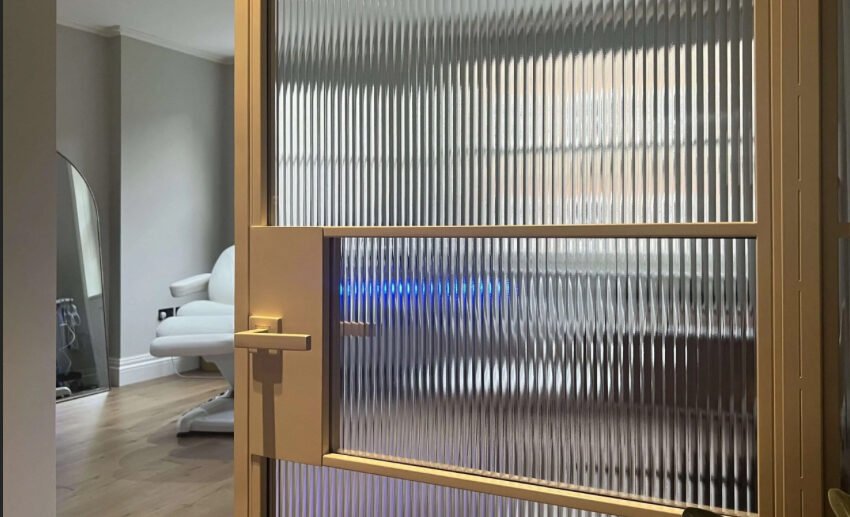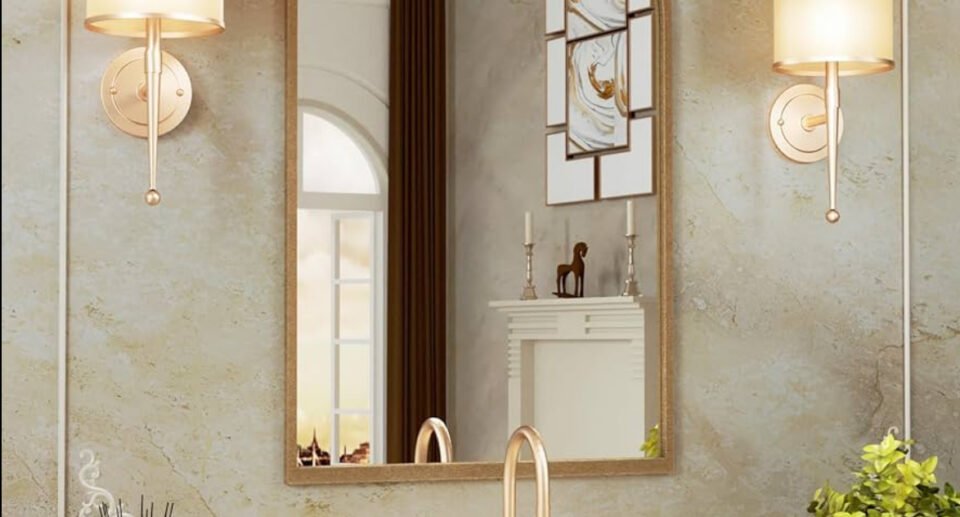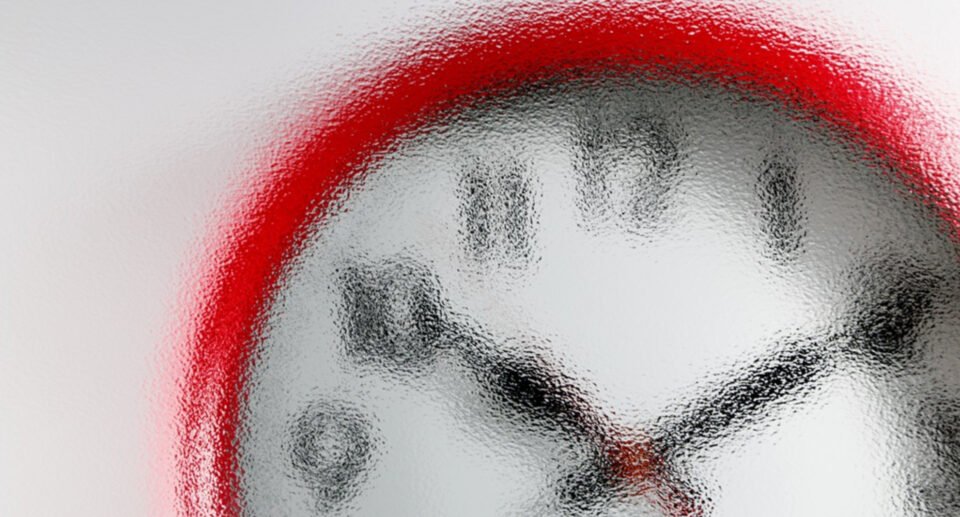Obscure Glass: What Is It? All You Need to Know

Table of Contents
ToggleObscure glass is a type of glass that reduces visibility and offers privacy. It is often used in windows, doors, partitions, and showers to provide a level of privacy while still allowing natural light to enter the room.
Obscure glass can be found in a variety of designs and patterns, ranging from frosted and textured to coloured and window film.
Manufacturing techniques for obscure glass vary depending on the desired level of obscurity. Frosted glass is created by etching or sandblasting the surface of the glass, while textured glass is made by rolling the glass through a machine that imprints a pattern onto the surface. Coloured glass is achieved by adding pigments to the glass during the manufacturing process.
Design and aesthetic considerations are also important when choosing obscure glass. The type of glass used can greatly impact the look and feel of a room.
It is important to consider the overall design aesthetic and choose a glass that complements it. Additionally, functional benefits such as solar control, thermal insulation, and noise reduction should also be taken into account when selecting obscure glass.
Key Takeaways
- Obscure glass is a type of glass that offers privacy while still allowing natural light to enter a room.
- Manufacturing techniques for obscure glass include etching, sandblasting, and adding pigments to the glass.
- When choosing obscure glass, it is important to consider both design and functional benefits such as solar control and thermal insulation.
Types of Obscure Glass
There are many types of obscure glass available, each with its unique properties. Here are some of the most common types of obscure glass:
Frosted Glass
Frosted glass is one of the most popular types of obscure glass. It is created by either sandblasting or acid-etching clear glass, which gives it a translucent appearance.
This type of glass allows light to pass through while maintaining privacy. Frosted glass is often used in bathrooms, shower enclosures, and office partitions.
Textured Glass

Textured glass is a type of glass that has a pattern or texture on its surface. It can be used to create different levels of privacy, depending on the level of texture.
Textured glass is available in various patterns, designs, and opacities, making it ideal for use in both residential and commercial settings.
Patterned Glass
Patterned glass is a type of textured glass that has a design or pattern on its surface. It can be used to create a decorative effect or to provide privacy.
Patterned glass is available in a wide range of designs and opacities, making it ideal for use in windows, doors, and partitions.
Satin Glass
Satin glass is a type of glass that has been chemically treated to create a smooth, frosted appearance. It is often used in bathrooms, shower enclosures, and office partitions.
Satin glass is available in various levels of opacity, making it an excellent choice for creating privacy while allowing light to pass through.
Acid-Etched Glass
Acid-etched glass is created by applying acid to clear glass, which creates a frosted appearance. This type of glass is often used in bathrooms, shower enclosures, and office partitions.
Acid-etched glass is available in various levels of opacity, making it an excellent choice for creating privacy while allowing light to pass through.
Sandblasted Glass
Sandblasted glass is created by blasting sand or other abrasive materials at high speed onto clear glass. This process creates a frosted appearance, which makes it ideal for use in bathrooms, shower enclosures, and office partitions.
Sandblasted glass is available in various levels of opacity, making it an excellent choice for creating privacy while allowing light to pass through.
Tinted and Coloured Glass
Tinted and coloured glass is created by adding a tint or colour to clear glass. This type of glass is often used in windows, doors, and partitions to create a decorative effect or to provide privacy.
Tinted and coloured glass is available in a wide range of colours and opacities, making it ideal for use in both residential and commercial settings.
Manufacturing Techniques
Obscure glass can be produced using a variety of manufacturing techniques, each with their own unique benefits and drawbacks. In this section, we will explore some of the most common techniques used to produce obscure glass.
Chemically Treated Glass
One method of creating obscure glass is through chemical treatment. This process involves applying a chemical solution to the surface of the glass, which alters its texture and appearance.
The level of obscurity can be controlled by adjusting the concentration of the chemical solution and the length of time it is applied to the glass.
Laminated Glass Production
Laminated glass is another popular method for creating obscure glass. This process involves sandwiching a layer of plastic or resin between two sheets of glass.
The plastic layer can be tinted or textured to create the desired level of obscurity.
Toughened Glass Process
Toughened glass, also known as tempered glass, is a type of glass that is heated to a high temperature and then rapidly cooled. This process creates a glass that is stronger and more durable than regular glass.
Obscure toughened glass can be produced by adding a layer of film to the surface of the glass, which can be tinted or textured to create the desired level of obscurity.
Design and Aesthetic Considerations
When incorporating obscure glass into a space, several design and aesthetic considerations need to be kept in mind. Here are some of the key factors to consider:
Opacity and Transparency
One of the most important considerations when choosing obscure glass is the level of opacity and transparency.
Textured glass is a popular option for those who want to maintain some level of privacy while still allowing light to filter through.
Glass can be rated from 1 to 5, with 1 being the most transparent and 5 being the most opaque. For those who want maximum privacy, glass types with ratings of 4 and above are recommended.
Designs and Patterns
Obscure glass comes in a variety of designs and patterns, which can add visual interest to a space.
Sandblasted or acid-etched glass is a popular option for those who want a frosted look, while intricate patterns can add a unique touch to a room.
Some popular designs include rain, glue-chip, and frosted glass patterns. It’s important to choose a design that complements the overall aesthetic of the space.
Colour and Texture
Obscure glass can also be coloured or stained to add a pop of colour to a room.
Satinised glass is a popular option for those who want a smooth, matte finish, while coloured or stained glass can add a more vibrant touch.
It’s important to choose a colour and texture that complements the overall aesthetic of the space.
Customisation Options
For those who want a truly bespoke look, there are many customisation options available.
Glass can be cut to any size or shape, and patterns can be created to suit any design aesthetic.
It’s important to work with a reputable glass supplier who can provide expert advice on the best options for your space.
Functional Benefits and Applications
Obscure glass is a versatile material that offers a range of functional benefits and applications. In this section, we will explore some of the key benefits of using obscure glass and its various applications.
Privacy and Light Control
One of the most significant benefits of using obscure glass is its ability to provide privacy while still allowing natural light to enter the room.
Obscure glass diffuses light, making it an excellent choice for bathrooms, shower screens, and other areas where privacy is essential.
Obscure glass comes in different levels of obscurity, allowing you to choose the right level of privacy for your needs.
Safety and Security
Obscure glass is also toughened, making it a safer option than regular glass.
Toughened glass is more durable and less likely to break, reducing the risk of accidents and injuries.
Additionally, in the unlikely event that it does break, it shatters into small, blunt pieces, reducing the risk of injury from sharp edges.
Thermal and Acoustic Insulation
Obscure glass can also provide thermal and acoustic insulation.
Double glazing, which includes an extra layer of glass, can help to reduce heat loss and noise pollution, making it an excellent choice for homes and businesses in noisy or cold areas.
Architectural Usage
Obscure glass has a wide range of applications in both residential and commercial buildings. The glass is designed to allow light to pass through while obscuring the view from outside. This makes it ideal for use in areas where privacy is a concern.
Residential Applications
In residential buildings, obscure glass is commonly used in bathroom windows and shower screens. The glass allows natural light to enter the bathroom while maintaining privacy.
Additionally, it can be used in interior doors to provide privacy between rooms without blocking light.
Commercial Applications
Obscure glass is also widely used in commercial buildings.
It can be used in office partitions to create private workspaces while still allowing light to pass through. Additionally, it is commonly used in storefronts to provide privacy for businesses while still allowing customers to see inside.
Installation and Maintenance
Installation Guidelines
When installing obscure glass, it is important to follow the manufacturer’s guidelines to ensure safety and optimal performance.
It is recommended to hire a professional glazier to install the glass, as they have the necessary expertise and tools to do the job correctly.
Before installation, make sure to measure the space accurately to ensure that the glass fits properly.
It is also important to choose the right type of obscure glass for the intended purpose. For example, some types of obscure glass may be more suitable for bathrooms, while others may be better for front doors.
In terms of budget, obscure glass can be more expensive than regular glass, but it is important to consider the long-term benefits in terms of privacy and aesthetics.
Cleaning and Upkeep
To maintain the appearance and functionality of obscure glass, it is important to clean it regularly.
Use a soft cloth or sponge and a mild detergent to clean the glass, and avoid using abrasive materials that could scratch the surface.
It is also important to check the glass periodically for any damage or cracks, and to have any issues repaired promptly to ensure safety.
Regular maintenance and upkeep can help to extend the lifespan of the glass and ensure optimal performance.
Comparisons and Considerations
Obscure vs Transparent Glass
When choosing between obscure and transparent glass for your windows, there are a few things to consider. Transparent glass allows for maximum visibility and natural light to pass through, making it ideal for rooms that require a lot of natural light. However, this also means that transparent glass offers little to no privacy, which can be a concern for some homeowners.
On the other hand, obscure glass offers a certain level of privacy, while still allowing natural light to pass through. This makes it an ideal choice for bathrooms, bedrooms, and other areas where privacy is important. Obscure glass comes in a variety of textures and patterns, allowing you to choose the level of privacy that works best for your needs.
Cost and Budgeting
When it comes to cost and budgeting, transparent glass is generally the more affordable option. This is because it is easier to produce and requires less processing than obscure glass. However, the cost of obscure glass can vary depending on the texture and pattern you choose.
While transparent glass may be the more budget-friendly option, it’s important to consider the long-term benefits of obscure glass. For example, it can help to reduce energy costs by blocking out UV rays and reducing heat transfer. Additionally, it can provide added security by making it more difficult for potential intruders to see into your home.
Regulatory Standards and Compliance
When incorporating obscure glass into a building project, it is important to be aware of the relevant regulatory standards and compliance requirements. This section will cover some of the key safety regulations and building codes that apply to the use of obscure glass.
Safety Regulations
Safety is a top priority when using glass in building projects. Safety regulations are in place to ensure that glass is used in a way that minimizes the risk of injury or damage. One of the key safety regulations that applies to the use of glass is the requirement for toughened glass in certain applications.
Toughened glass is a type of safety glass that is designed to break into small, rounded pieces when it is shattered. This makes it less likely to cause injury or damage. Toughened glass is required in certain applications, such as glazed doors and side panels, where there is a risk of impact.
Building Codes
Building codes are another important consideration when using obscure glass in building projects. Building codes set out the minimum requirements for the design, construction, and performance of buildings. There are a number of building codes that apply to the use of glass in buildings.
One of the key building codes to be aware of is the requirement for safety glazing. Safety glazing is required in certain applications, such as glazed panels on walls and partitions up to 800mm from floor level, and glazed doors up to 1500mm from floor level. Safety glazing is also required on any side panel to a door up to 300mm from the edge of the door, up to 1500mm from floor level.
In addition to safety glazing, there are also building codes that set out requirements for the thermal performance of glazed elements, as well as requirements for the fire resistance of glazed elements in certain applications.
Frequently Asked Questions
Obscure glass comes in a variety of patterns, each with its own unique level of privacy and light transmission. The most common patterns include textured glass, frosted glass, satinised glass, coloured or stained glass, and window film. Pilkington, a leading glass manufacturer, offers a range of obscure glass designs such as Taffeta, Sycamore, Stippolyte, Pelerine, Oak, Minster, Mayflower, Florielle, Flemish, Everglade, Cotswold, Contour, Charcoal, Chantilly, Autumn and Arctic, as well as a wide range of custom designs.
Frosted glass is a type of obscure glass that has been sandblasted or acid-etched to create a frosted appearance. It provides a high level of privacy and diffuses light, making it ideal for use in bathrooms, shower enclosures, and partitions. However, frosted glass can also reduce the amount of natural light that enters a room, making it less suitable for areas where maximum light transmission is desired.
Contemporary interiors often feature sleek, minimalist designs that incorporate elements of nature and the outdoors. As such, popular obscure glass designs for contemporary interiors include those that mimic natural patterns such as leaves, branches, and flowers. These designs can add a touch of sophistication and elegance to any modern space.
The most popular obscure glass pattern for residential use is textured glass. Textured glass is available in a range of patterns and provides a high level of privacy while still allowing natural light to enter a room. It is commonly used in bathrooms, entryways, and other areas where privacy is desired.
Pilkington offers a wide range of obscure glass options, including Taffeta, Sycamore, Stippolyte, Pelerine, Oak, Minster, Mayflower, Florielle, Flemish, Everglade, Cotswold, Contour, Charcoal, Chantilly, Autumn and Arctic, as well as custom designs. These patterns are available in a range of thicknesses and sizes to suit any application.
Obscure glass maintains privacy by diffusing light and obscuring the view of objects behind it. This is achieved through the use of patterns, textures, or coatings that scatter or reflect light in different directions.
While obscure glass reduces the amount of light that enters a room, it still allows a significant amount of natural light to pass through. This makes it an ideal solution for areas where privacy is desired without sacrificing natural light.

Hello, I’m Keith Jones. I’m the author and head of content here of door and window guide. I’ve been in the window and door industry for over 10 years in the UK and North America. I’ve had quite a few roles during my career mainly in Worldwide sales. I’m now semi retired so I thought I’d put my knowledge to good use educating people about all they might need to know about door and window related topics.






